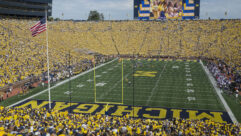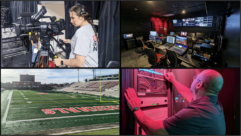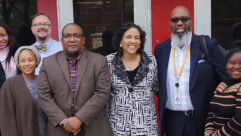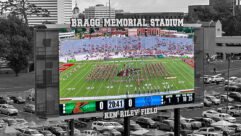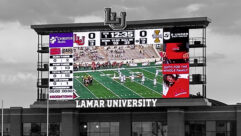
The Buzz: Installation spotlight: Cameron Indoor Stadium, Duke University, Durham, N.C.
May 1, 2008 12:00 PM,
By Jessaca Gutierrez
Zone Defense

When Duke University in Durham, N.C., decided to update the AV system in its historical Cameron Indoor Stadium, Justo Gutierrez of SPL Integrated Solutions recommended a visually unobtrusive distributed sound system employing a combination of EAW AX Series long-throw and MK Series short-throw loudspeakers to accommodate the low ceilings and to allow for configuration to suit the different events hosted
at the facility.
Cameron Indoor Stadium, on the Duke University campus in Durham, N.C., has a rich legacy. Legend has it that the arena was conceived on a back of a matchbook. Whether or not that’s true, at the time it was built in 1940, Cameron was the East Coast’s largest indoor stadium — seating 7,000 people. Although it is now considered a relatively small facility compared to some of today’s monolithic indoor stadiums, Cameron remains an important facility in the world of collegiate athletics because it is central to the prolific and rich basketball tradition at Duke.
While many schools of a similar age have chosen to replace their old arenas with more modern, larger facilities, Duke has chosen to preserve Cameron.
“What they have done at Duke is to take a new-wine-in-old-bottles approach, where they want to keep the history and the charm of the building while modernizing it with technological updates that are tasteful,” says Justo Gutierrez, former Duke alumnus and project engineer with SPL Integrated Solutions in Columbia, Md. (which recently merged with Tampa, Fla.-based Audio Visual Innovations), the company that worked on a recent audio upgrade to the facility. “This is one example where they really wanted to update the sound system, but they wanted to keep the architectural impact as minimal as possible.”
The last notable update to the facility took place in 1988, when the school increased the seating capacity to 9,314 and put in a new scoreboard, interior paneling, and a center-hung cluster sound system — the same sound system that served the facility until last year, when Duke invited SPL to submit designs for a new sound system.
After a site survey, Gutierrez recommended a distributed system because it would lend itself well to the low ceiling height, provide the least visual impact, and supply the university with a system that could be configured to the type of event hosted at the facility — from basketball and volleyball games to banquets.
Gutierrez selected a combination of EAW AX Series long-throw and MK Series short-throw installation loudspeakers. Down the length of each side of the stadium, EAW AX344s — each accompanied by a single EAW SB250z compact dual-15in. loaded, direct-radiating subwoofer — (45-degree-by-45-degree dispersion) provide full coverage to the bleachers at throw distances of up to 60ft. MK2394 loudspeakers — mounted horizontally to stay out of sightlines — cover the upper seating areas, with their 90-degree-by-45-degree dispersion horns rotated to attain the desired coverage. Each MK2394 configuration includes two loudspeakers — one covering the top half of the seating area and the other seamlessly transitioning at the halfway point and extending coverage down to the front row. Single, tight loudspeaker groupings — composed of dual AX344 loudspeakers arrayed side by side to reach the bleachers and dual MK2394s to reach the upper seats — are flown centrally to cover the two deeper ends of the court, with a single SB250z subwoofer to bolster direct LF energy. Additional individual MK2394 loudspeakers are flown at strategic positions above the court to serve as monitor loudspeakers for halftime performers or for events such as commencements that need more focused audio.
The Buzz: Installation spotlight: Cameron Indoor Stadium, Duke University, Durham, N.C.
May 1, 2008 12:00 PM,
By Jessaca Gutierrez
Zone Defense
Additionally, SPL deployed three EAW UX8800 digital processors with Gunness Focusing algorithm technology. “[EAW UX8800] has been highly touted as something that can streamline the equalization process. Its DSP algorithms were designed to help correct the response of a loudspeaker digitally,” Gutierrez says. “In principle, it would minimize the amount of additional DSP that you would have to apply to equalize the system. [The UX8800] was the one new piece of gear that we used. What we found was that it really did shorten the amount of the time that we had to take to equalize the sound system. Many of the things that we usually try to EQ were already taken care of by the Gunness Focusing algorithm in the UX8800 processors.”
All the challenges of the installation didn’t take Gutierrez by surprise, he says, considering the age and design of the space. Although the building had had some acoustical treatment done in its past, this treatment had long since been removed, having the effect of making the Cameron Crazies even louder. “There is no real acoustical treatment in the building, and that contributes to the difficulty of the design because the building doesn’t behave like modern arenas that have a lot of acoustical treatment,” Gutierrez says. “When you start out with a building that is not well-behaved acoustically, it presents more challenges to produce something that will work.”
Retrofitting cable into historic spaces such as Cameron is often one of the largest challenges to such an installation, but the university had hired an electrical contractor who was familiar enough with the facility to install conduit and pull cable, not only shortening the installation time — meeting a collapsed schedule the school set because of events due to take place at the stadium — but allowing Gutierrez to turn his focus to loudspeaker placement. Because the loudspeaker design was limited by the steel structure of the space, Gutierrez had to work within an installation design that that could retrofit to the steel structure. “That puts some constraints on your loudspeaker design because you have to pick the appropriate devices that work at whatever spacing the structure and ceiling allow,” Gutierrez says. “Luckily, there was enough steel that we could come up with a design that was adequate.”
The equipment closet that had formerly housed the existing sound-system equipment racks would also house the new system technology, but the limited space that SPL had to work with meant that the company had to be selective on its equipment choice. Housed in the facility’s two equipment racks are the three UX8800 units, dual BSS Audio Soundweb London BLU-80 digital processors that provide system control and routing, four Shure UHF Series wireless microphone systems, and eight Lab.gruppen C Series 4-channel power amplifiers. The closet also houses two control interfaces, a small Yamaha LS9 digital mixing console, and a computer interface for configuring and running the sound system.
“Because the Yamaha mixer can be controlled remotely, they actually just plug into the sound system network port that is at half court and drive the sound system off the laptop with a mouse,” Gutierrez says. “They’re able to mix the game without taking a lot of equipment into the press row, which is something they were concerned about because there is very limited space.”
Upgrading the audio system provided more than just a better game experience for basketball fans. Employing the distributed system allowed the school more flexibility in issuing sound for only the zones needed. For smaller events, such as school commencements and wrestling matches, facility management can reconfigure the system to push sound to the appropriate zones with the simple push of a button.
“They went from a sound system that was basically barely adequate for public address and not music reproduction to something that was capable of rock and roll,” Gutierrez says.
SUBSCRIBE TO SOUND & VIDEO CONTRACTOR E-NEWSLETTERS!
- Sound & Video Contractor EXTRA
Systems Integration Special Focus series:
- Houses of Worship
- Corporate AV
- Residential AV
- AV Over Fiber
- AV in Education
Breaking industry news in your email inbox every other week!
Subscribe atwww.svconline.com


